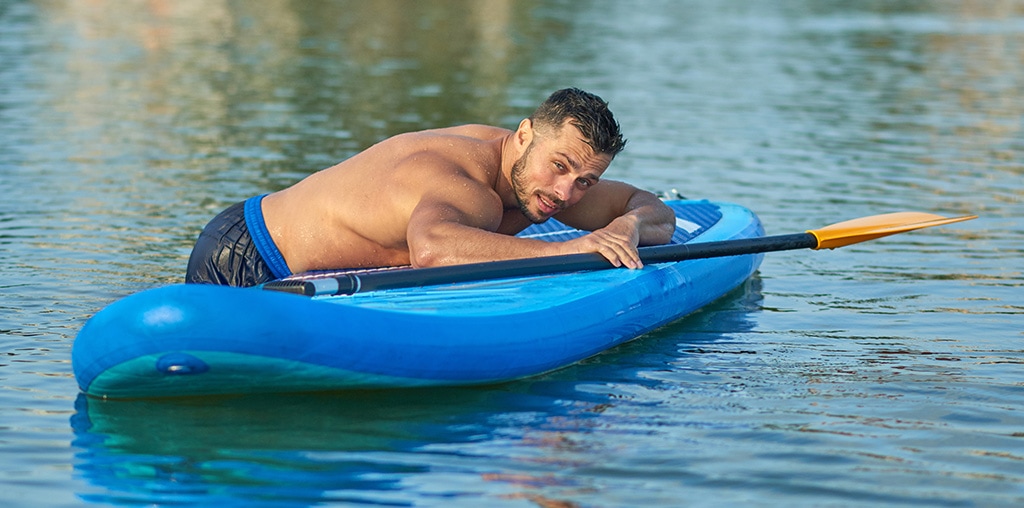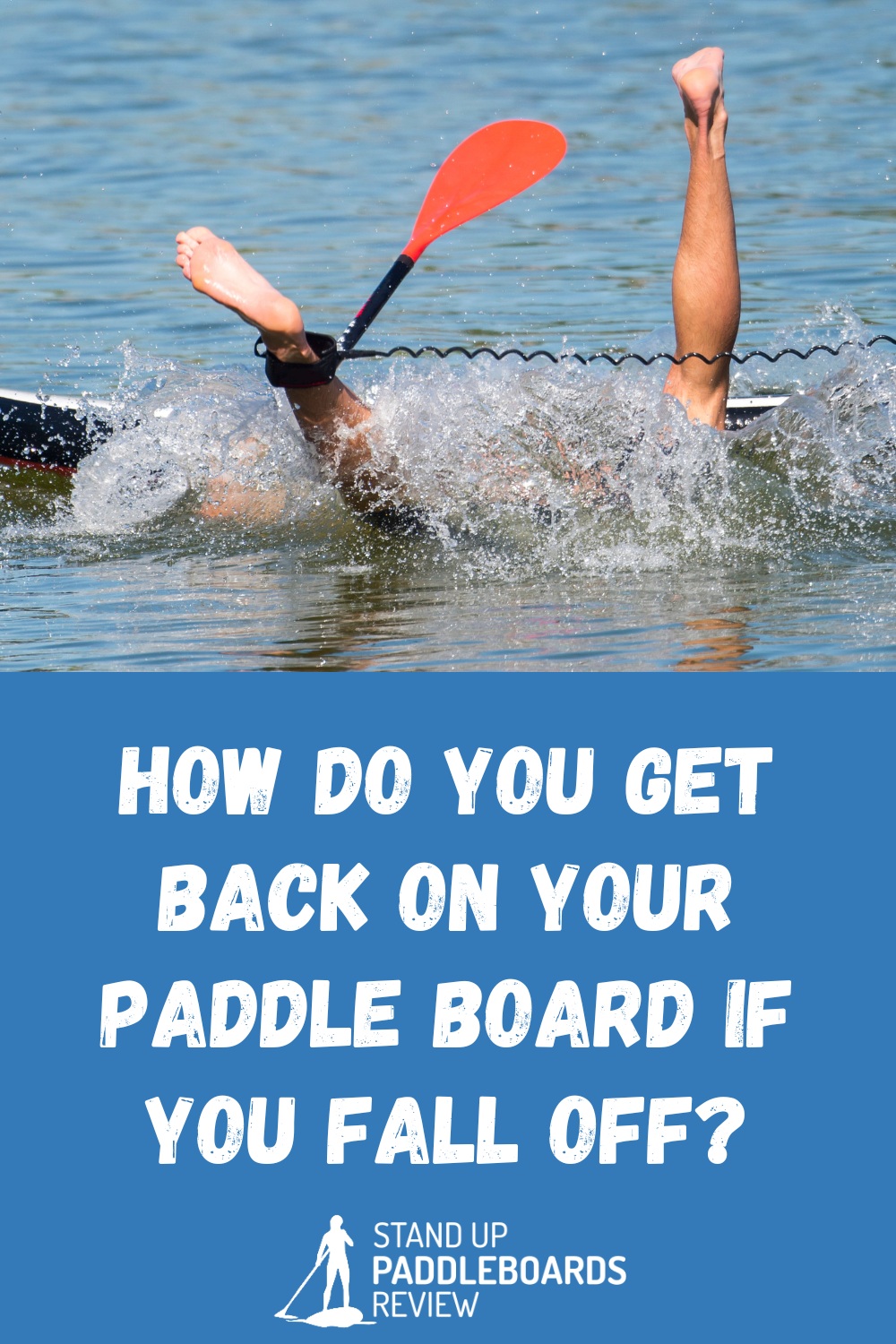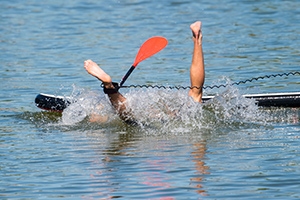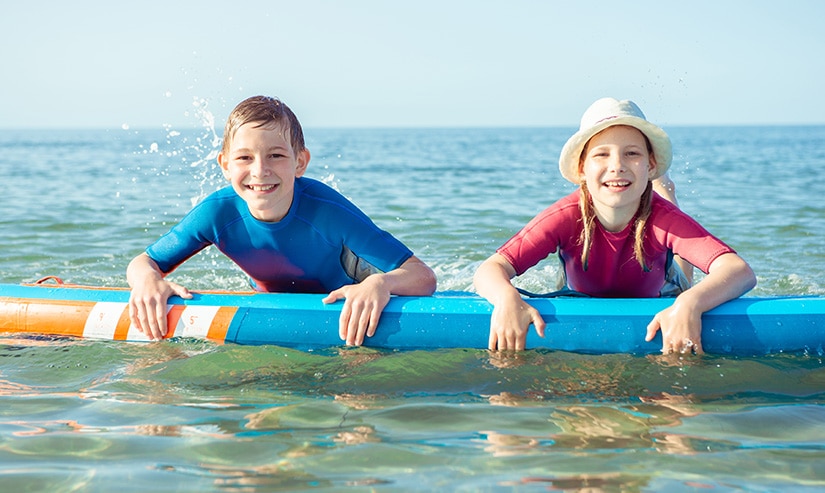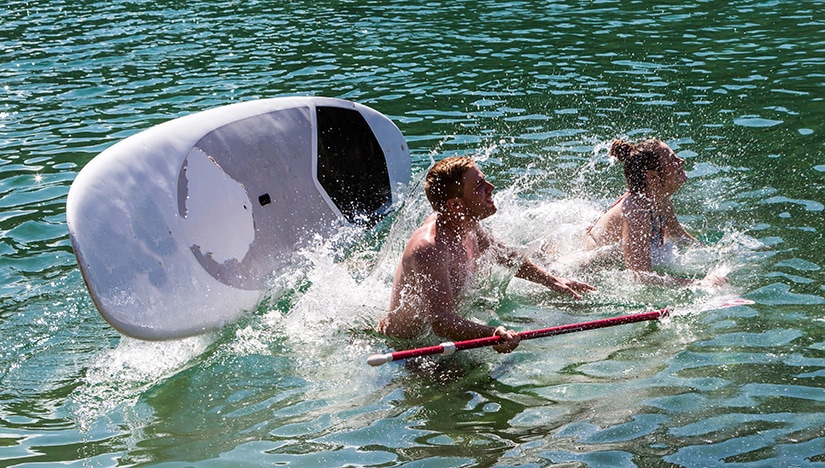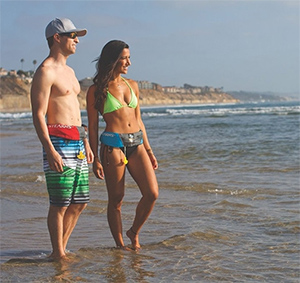Falling off your paddle board is inevitable while paddle boarding. But that’s not a bad thing and, if you’re a beginner, it’s nothing to be afraid of.
The thought of falling off a SUP can deter some people from ever wanting to get on a board. You might be one of those people. Maybe you think it’s embarrassing to fall – but there’s also the question of what to do after you fall! This can be one of the more daunting aspects of all – how do you get back on the board? Is it difficult? What do you do?
We’ll get to that in a minute. But first…
Key Takeaways
- Falling off a paddle board is normal and not a big deal, as long as you learn how to get back on your SUP safely and quickly.
- The best way to get back on a paddle board is from the side, using the center carry handle and the opposite rail to pull yourself onto the board.
- When you fall, you should fall away from the board and the paddle, land flat on the water, and relax. This will prevent you from getting injured by hitting the board, the paddle, or anything under the water.
- You should always wear a leash and a PFD when paddle boarding. The leash will keep your board close to you and the PFD will help you float and stay safe.
Is It Normal to Fall Off a Paddle Board?
Yes, as I’ve already mentioned falling off a paddle board is normal, and is all part of the SUP experience.
When you’re a beginner, learning how to achieve and maintain balance can be tricky. Paddle boards aren’t that big and standing raises your center of gravity, so balance takes some effort. That’s why it’s easy for newbies to fall.
However, you can reduce your chances of falling by getting a good quality board that’s suitable for beginners – like the Atoll 11 (which I’ve tested and reviewed, so I know it’s a great beginner paddle board).
You can also begin by paddling while in the kneeling or sitting position and get up to the standing position when you’re ready.
Even experienced paddlers fall every once in a while. It’s normal and not a big deal, as long as you learn how to get back on your SUP.
Speaking of…
Is It Hard to Get Back on a Paddle Board After Falling?
No, getting back on a stand up paddle board after falling isn’t hard. The fact that a paddle board is small and doesn’t have an enclosed deck makes things so much easier.
But it’s still a skill that you need to practice and master because you’ll need it.
The degree of difficulty depends on the water and weather conditions. When the water is rough and the winds are strong it can be more challenging compared to when conditions are calm.
Don’t worry though, with little practice you’ll be able to do it effortlessly in all types of conditions.
How Do You Get Back on a Paddle Board?
Let’s say you’ve fallen off your board. You’ve fallen safely (more on that later) and you want to quickly climb back onto your board and resume paddling. What next?
Swim to Your SUP First, Not Your Paddle
Hopefully, both your paddle and the paddle board will be close by. But if the two are drifting away and you have to choose to go after one of them, go after your SUP first.
You can’t use your paddle to retrieve your SUP board, but if you get on the board you can prone paddle board to your paddle.
And even without a paddle, you can paddle with your hands back to shore. A paddle won’t be of much help without the board.
This is also why you should always wear your paddle board leash–to prevent the SUP from drifting away, leaving you stranded.
Getting Back on the Board
The best way to get back on a stand up paddle board is from the side. You can get back on from the tail but it’s slightly harder, especially given how big paddle boards are.
Swim close to your paddle board and position yourself on the side. Grab the center carry handle and use it to pull yourself onto the board. Once your upper body is on the paddle board, grab the opposite rail and kick your feet so your legs float behind you and get the rest of your body onto the SUP.
Paddle in the prone position to retrieve your paddle and your gear–if any of it fell into the water.
If you want to try getting back on from the tail, swim to the back of the SUP. Put both hands on the deck at the tail and press it down then push your body onto the paddle board. Grab the rail on either side with a firm grip, kick your feet behind you and push the rest of your body onto the SUP. Then slide to the middle.
Once you get to the center of the paddle board, paddle while in the kneeling position then slowly rise and continue paddling to stay balanced.
Here is a video showing you how to get back on your board.
Falling off ‘Correctly’ Is Also Important
In order to be able to really explain the ins and outs of mounting your board from the water, it’s also important to explain how the way you fall off your board can have an impact.
How you fall can help (or hinder) you getting back on the board. It’s also important to know how to fall properly in order to stay safe on the water.
How to Fall Off a Paddle Board Safely
Properly falling off a SUP board could save you from getting injured. So, keep all of these tips in mind while you’re paddling, and if you feel you’re about to fall, try to implement them!
Fall Away from the SUP Board
Stand up paddle boards are not made using soft materials. Even inflatable SUPs are pretty rigid when fully inflated. While the hardness and rigidity of paddle boards is good for performance, it’s not an ideal surface to fall on.
If you fall and hit your paddle board you could get hurt–especially if you hit your head.
When you feel yourself losing balance, fall away from the board and don’t try to hold on to it. Landing on the water is the safer option because it is softer and you’re less likely to get injured.
This won’t come naturally to you as you’ll want to hold on to your paddle and paddle board. But you don’t have to worry about that because you can easily get to your SUP as long as you’re wearing your paddle board leash.
Make sure you don’t fall on your paddle too as that could also hurt.
Try to Fall Flat
Another thing you need to be aware of is what lies in the water. There could be something hard or sharp below the water surface that could injure you–especially with the impact of falling.
Always avoid falling into the water head first and instead try to land flat, whether you’re paddling in shallow water or deep water. Falling flat reduces the impact of the fall and you also won’t go in too deep. So you’ll avoid hitting whatever is under the water and potentially getting injured.
Relax (Just Let is Happen)
This is an important tip, especially for newbies. When you panic or fight the fall, you might end up trying to hold onto the board. This is a mistake, as pointed out above, because you could hit yourself and get hurt.
Instead, relax and focus on landing flat, away from your paddle board. Then you can get back on your board and continue with your SUP session.
A Few Useful SUP Tips to Keep in Mind
Here are some tips to help you with falling and getting back on a SUP.
Always Wear a PFD
Never get on your paddle board without a life jacket or PFD on. The law requires you to have it somewhere on your SUP but remember that it only works if you wear it.
Should you fall, your personal flotation device will help you fall shallow–which is what you want–and swim back to your board quickly.
It will also prevent you from drowning if you get caught up in a bad situation.
Wear a Leash at All Times
Wearing a leash prevents your paddle board from drifting away when you fall into the water. So you can retrieve it easily. Otherwise, you might get in trouble, especially in an emergency.
Being attached to your board ensures that you have a floating surface that you can use to get back to land.
Practice in a Safe Location
Don’t wait until you fall off your SUP while out paddling to practice getting back on. Find a place with calm, clear water and practice there. It’s also better to have a skilled person to help you.
Wrapping Up
Getting back on your paddle board is not difficult, you only need to practice until you’re good at it.
Remember: never get on a paddle board without a leash and a PFD. With a leash, you won’t have to worry about your SUP drifting too far away from you. A life jacket helps you fall shallow and prevents you from drowning. So wear the two at all times.
Happy paddling!

